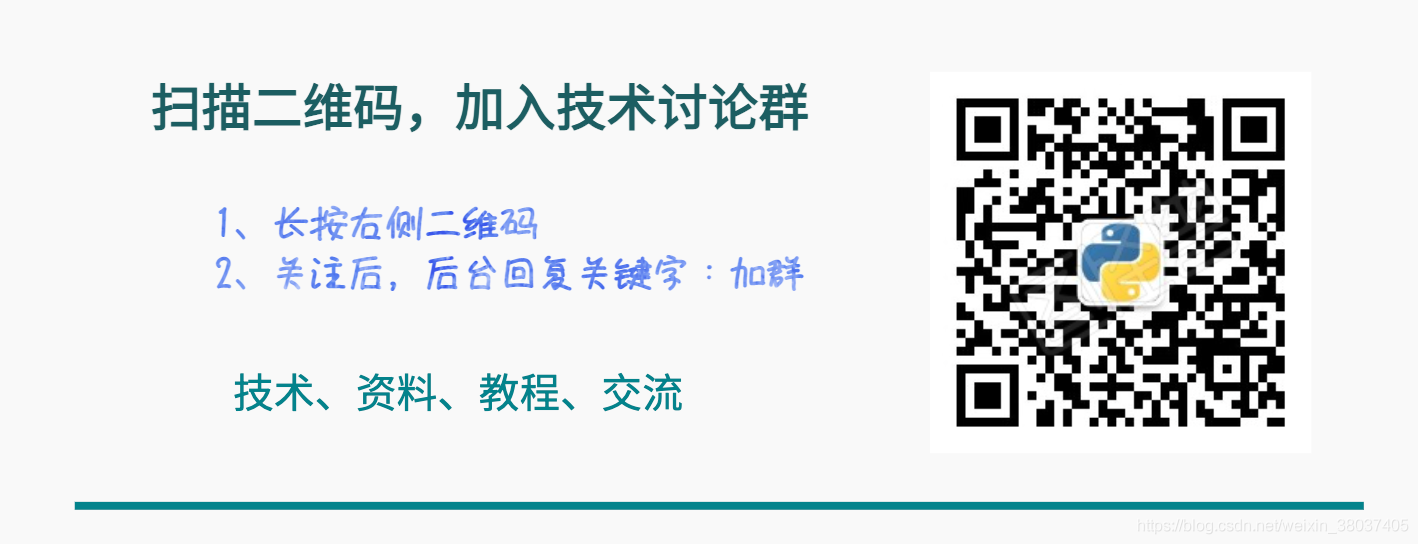Welcome to focus on Python, data analysis, data mining and fun tools!
Hello, everyone, today I'd like to share 40 Python tips. If it's helpful to you, please give me a little praise. Pay attention to me. I won't get lost. Later, I'll write more practical skills, technical exchange and learning. You can get the way to join at the end of the article.
0. The two variable values are interchangeable
>>> a=1 >>> b=2 >>> a,b=b,a >>> a 2 >>> b 1
1. Continuous assignment
a = b = c = 50
2. Automatic unpacking
>>> a,b,c = [1,2,3] >>> a 1 >>> b 2 >>> c 3 >>> >>> >>> a, *others = [1,2,3,4] >>> a 1 >>> others [2, 3, 4] >>>
4. Chain comparison
a = 15
if (10 < a < 20):
print("Hi")
Equivalent to
a = 15
if (a>10 and a<20):
print("Hi")
5. Duplicate list
>>> [5,2]*4 [5, 2, 5, 2, 5, 2, 5, 2]
6. Duplicate string
>>> "hello"*3 'hellohellohello'
7. Ternary operation
age = 30 slogon = "fucking great" if age == 30 else "niubility"
Equivalent to
if age == 30:
slogon = "fucking great"
else:
slogon = "niubility"
8. Dictionary merge
>>> a= {"a":1}
>>> b= {"b":2}
>>> {**a, **b}
{'a': 1, 'b': 2}
>>>
9. String inversion
>>> s = "i love python" >>> s[::-1] 'nohtyp evol i' >>>
10. List to string
>>> s = ["i", "love", "pyton"] >>> " ".join(s) 'i love pyton' >>>
11. for else statement
Check whether the list foo has 0. If yes, the search will be ended in advance. If not, the "not found" will be printed“
found = False
for i in foo:
if i == 0:
found = True
break
if not found:
print("Not found")
If you use the for else syntax to write, you can save a few lines of code
for i in foo:
if i == 0:
break
else:
print("Not found")
11. Dictionary derivation
>>> m = {x: x**2 for x in range(5)}
>>> m
{0: 0, 1: 1, 2: 4, 3: 9, 4: 16}
>>>
12. Use Counter to find the most elements in the list
>>> content = ["a", "b", "c", "a", "d", "c", "a"]
>>> from collections import Counter
>>> c = Counter(content)
>>> c.most_common(1)
[('a', 3)]
>>>
The first most element is a, which appears three times. You can also find the second or third most element in a similar way
13. Default value dictionary
Set the value in the dictionary as the list, which is the common method
>>> d = dict()
if 'a' not in d:
d['a'] = []
d['a'].append(1)
Use the defaultdict default dictionary to build a dictionary whose initial value is an empty list
from collections import defaultdict d = defaultdict(list) d['a'].append(1)
14. Assignment expression
This is a new feature of 3.8, and the assignment expression becomes the walrus operator: =, you can put the variable assignment and expression on one line. What does it mean? Just look at the code
>>> import re
>>> data = "hello123world"
>>> match = re.search("(\d+)", data) # 3
>>> if match: # 4
... num = match.group(1)
... else:
... num = None
>>> num
'123'
Lines 3 and 4 can be combined into one line of code
>>> if match:=re.search("(\d+)", data):
... num = match.group(1)
... else:
... num = None
...
>>> num
'123'
15. Instance
The isinstance function can be used to judge the type of an instance. In fact, the second parameter can be a tuple composed of multiple data types. For example:
isinstance(x, (int, float)) # Equivalent to isinstance(x, int) or isinstance(x, float)
Similar functions include startswitch and endswitch of strings, for example:
s.startswith(('"""', "'''"))
# Equivalent to
s.startswith("'''") or s.startswith('"""')
16. Share files with http.server
# python3 python3 -m http.server # python2 python -m SimpleHTTPServer 8000
17. The zip function realizes the exchange of dictionary key value pairs
>>> lang = {"python":".py", "java":".java"}
>>> dict(zip(lang.values(), lang.keys()))
{'.java': 'java', '.py': 'python'}
18. Find the number that appears most frequently in the list
test = [1, 2, 3, 4, 2, 2, 3, 1, 4, 4, 4, 5] >>> max(set(test), key=test.count) 4
19. Use slots to save memory
class MyClass(object):
def __init__(self, name, identifier):
self.name = name
self.identifier = identifier
self.set_up()
print(sys.getsizeof(MyClass))
class MyClass(object):
__slots__ = ['name', 'identifier']
def __init__(self, name, identifier):
self.name = name
self.identifier = identifier
self.set_up()
print(sys.getsizeof(MyClass))
# In Python 3.5
# 1-> 1016
# 2-> 888
20. Extended list
>>> i = ['a','b','c'] >>> i.extend(['e','f','g']) >>> i ['a', 'b', 'c', 'e', 'f', 'g'] >>>
21. List negative index
>>> a = [ 1, 2, 3] >>> a[-1] 3
22. List slice
>>> a = [0,1,2,3,4,5,6,7,8,9] >>> a[3:6] # Elements between 3rd and 6th [3, 4, 5] >>> a[:5] # First 5 elements [0, 1, 2, 3, 4] >>> a[5:] # Last 5 elements [5, 6, 7, 8, 9] >>> a[::] # All elements (copy list) [0, 1, 2, 3, 4, 5, 6, 7, 8, 9] >>> a[::2] # Even term [0, 2, 4, 6, 8] >>> a[1::2] # Odd term [1, 3, 5, 7, 9] >>> a[::-1] # Reverse list [9, 8, 7, 6, 5, 4, 3, 2, 1, 0]
23. Two dimensional array becomes one-dimensional array
import itertools >>> a = [[1, 2], [3, 4], [5, 6]] >>> i = itertools.chain(*a) >>> list(i) [1, 2, 3, 4, 5, 6]
24. Indexed iteration
>>> a = ['Merry', 'Christmas ', 'Day']
>>> for i, x in enumerate(a):
... print '{}: {}'.format(i, x)
...
0: Merry
1: Christmas
2: Day
25. List derivation
>>> le = [x*2 for x in range(10)] >>> le # Multiply each number by two [0, 2, 4, 6, 8, 10, 12, 14, 16, 18] >>> le = [x for x in range(10) if x%2 == 0] >>> le # Get even items [0, 2, 4, 6, 8]
26. Generator expression
>>> ge = (x*2 for x in range(10)) >>> ge <generator object <genexpr> at 0x01948A50> >>> next(ge) 0 >>> next(ge) 2 >>> next(ge) 4 ... >>> next(ge) Traceback (most recent call last): File "<stdin>", line 1, in <module> StopIteration
27. Set derivation
Python
>>> nums = {n**2 for n in range(10)}
>>> nums
{0, 1, 64, 4, 36, 9, 16, 49, 81, 25}
28. Judge whether the key exists in the dictionary
>>> d = {"1":"a"}
>>> d['2']
Traceback (most recent call last):
File "<stdin>", line 1, in <module>
KeyError: '2'
>>> '1' in d
True
>>> d['1']
'a'
>>> d.get("1")
'a'
>>> d.get("2")
>>>
29. Decorator
from functools import wraps
def tags(tag_name):
def tags_decorator(func):
@wraps(func)
def func_wrapper(name):
return "<{0}>{1}</{0}>".format(tag_name, func(name))
return func_wrapper
return tags_decorator
@tags("p")
def get_text(name):
"""returns some text"""
return "Hello " + name
print(get_text("Python"))
>>><p>Hello Python</p>
30. Dictionary subset
>>> def sub_dicts(d, keys):
... return {k:v for k, v in d.items() if k in keys}
...
>>> sub_dicts({1:"a", 2:"b", 3:"c"}, [1,2])
{1: 'a', 2: 'b'}
31. Reverse dictionary
>>> d = {'a': 1, 'b': 2, 'c': 3, 'd': 4}
>>>
>>> zip(d.values(), d.keys())
<zip object at 0x019136E8>
>>> z = zip(d.values(), d.keys())
>>> dict(z)
{1: 'a', 2: 'b', 3: 'c', 4: 'd'}
32. Named tuple
>>> from collections import namedtuple
>>> Point = namedtuple("Point", "x,y")
>>> p = Point(x=1, y=2)
>>> p.x
1
>>> p[0]
1
>>> p.y
2
>>> p[1]
2
33. Set dictionary default value
>>> d = dict()
>>> if 'a' not in d:
... d['a'] = []
...
>>> d['a'].append(1)
>>> d
{'a': [1]}
>>> d.setdefault('b',[]).append(2)
>>> d
{'a': [1], 'b': [2]}
>>>
34. Ordered dictionary
>>> d = dict((str(x), x) for x in range(10)) >>> d.keys() # key disorder dict_keys(['0', '1', '5', '9', '4', '6', '7', '8', '2', '3']) >>> from collections import OrderedDict >>> m = OrderedDict((str(x), x) for x in range(10)) >>> m.keys() # Keys are arranged in the order of insertion odict_keys(['0', '1', '2', '3', '4', '5', '6', '7', '8', '9'])
35. The maximum and minimum first n numbers in the list
>>> import heapq a = [51, 95, 14, 65, 86, 35, 85, 32, 8, 98] >>> heapq.nlargest(5,a) [98, 95, 86, 85, 65] >>> heapq.nsmallest(5,a) [8, 14, 32, 35, 51] >>>
36. Open the file
>>> with open('foo.txt', 'w') as f:
... f.write("hello")
...
37. Combine the two lists into a dictionary
list_1 = ["One","Two","Three"] list_2 = [1,2,3] dictionary = dict(zip(list_1, list_2)) print(dictionary)
38. Remove duplicate elements from the list
my_list = [1,4,1,8,2,8,4,5] my_list = list(set(my_list)) print(my_list)
39. Print calendar
import calendar
>>> print(calendar.month(2021, 1))
January 2021
Mo Tu We Th Fr Sa Su
1 2 3
4 5 6 7 8 9 10
11 12 13 14 15 16 17
18 19 20 21 22 23 24
25 26 27 28 29 30 31
40. Anonymous function
def add(a, b):
return a+b
Equivalent to
>>> add = lambda a,b:a+b >>> add(1,2) 3
Technical exchange
Welcome to reprint, collect, gain, praise and support!

At present, a technical exchange group has been opened, with more than 2000 group friends. The best way to add notes is: source + Interest direction, which is convenient to find like-minded friends
- Method ① send the following pictures to wechat, long press identification, and the background replies: add group;
- Method ②: add micro signal: Python 666, remarks: from CSDN
- WeChat search official account: Python learning and data mining, background reply: add group
